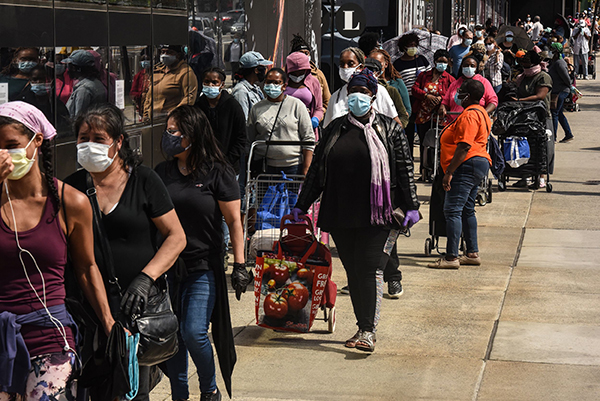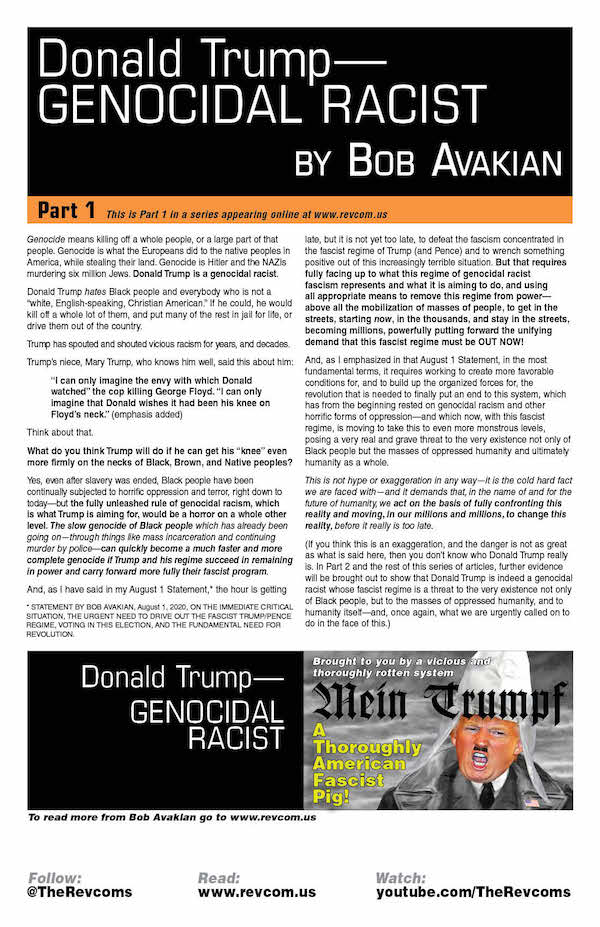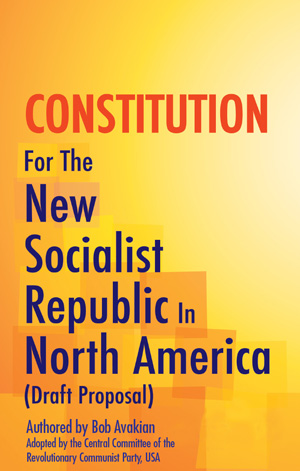What Donald Trump’s Claims About Black Unemployment Reveal and Conceal...
The Reality of Systemic Racism and the U.S. Labor Market
by Raymond Lotta
| revcom.us
Editors’ Note: In light of the Genocidal Racist Donald Trump’s promises and lies to Black people, the following remains a relevant and a standing refutation of his lies.
The racist-genocidal Trump has touted an economy that, under his watch, has been “working great” for Black people. In particular, he points to record low unemployment for Black people before the pandemic and economic crisis of March-April this year.
1) What is the actual reality?
Unemployment did come down during the Trump years. The unemployment rate for Black workers fell to a 50-year low of 6.1 percent in 2019. But that is only one side of the picture. The other side, and the side that Trump completely and consciously ignores, is that inequality has not changed. This 6 percent unemployment rate was double that of white workers. In fact, Black unemployment has been persistently twice the level of white workers—a defining economic reality for Black people under this system over the last 50 years—through expansions and economic downturns.
You will also notice that in Trump’s boasts, he takes you up to the COVID-19 crisis, and stops there. Conveniently so, because when the pandemic hit, with the economy going into deep crisis, overall unemployment skyrocketed.
Trump skates over—he could do no less!—that Black workers have been suffering severely in two ways by the pandemic-economic crisis. On the one hand, African-American workers are concentrated in sectors like retail and services that shut down, leading to rapid loss of jobs. On the other, Black workers are also heavily employed in jobs that have been designated as “essential” or “frontline”—like grocery, public transit, trucking, and warehouse. As a result, Black workers were forced to expose themselves disproportionately to the risk of contracting COVID-19 and spreading it to others. As with many “frontline” workers, this was the price of being able to keep their families fed.
2) The economic recovery of the past decade and the workings of capitalism
Why did unemployment come down in the last few years before the pandemic? For sure, it was not the result of special measures taken, or concern shown by the Trump regime, for people of color.
The bigger picture is that starting in 2010 and continuing through 2019, the U.S. economy entered into a recovery from the deep global recession of 2008-09. This recovery continued through Trump’s first term... until the onset of the pandemic in March-April and an unprecedented economic crisis. (See “Four Months Into the COVID-19 Pandemic...”.)
When the capitalist economy expands, the owners of the factories, telecommunications, warehouses, retail stores, and other sectors of the economy hire workers: hired to be exploited for profit to serve the competitive battle among capitalists to gain markets and to increase profits. When conditions for profitable production deteriorate, workers are tossed out.
Here is a basic truth about capitalism: the capitalists have the right to exploit workers, to hire and fire—even if that means millions go hungry. You see, under this system, there is no right to eat.
3) The stark, howling inequality beneath the unemployment numbers
The economic recovery of 2010-19 has had profoundly unequal effects. Not only have Black workers suffered unemployment at twice the rate of white workers... they are also are more likely to be unemployed than white workers at every age and educational level, even with college or advanced degrees. For instance, in 2019, the unemployment rate for Black college graduates was 50 percent higher than it was for white college graduates. And when Black workers experience unemployment, they are unemployed for longer spans of time.
We can dig deeper into Black-white racial inequality in the U.S. labor market and its consequences:
*There is a persistent “pay gap” between Black and white workers. On average, Black workers are paid 73 cents on the white dollar. This pay gap has actually widened since 2000.
*The jobs Black workers hold generally offer fewer benefits, like health insurance and sick days. This is a major contributing factor to the higher incidence of chronic illness among Black people relative to white people.
This brings us to another defining feature of the U.S. economy. This is what is called occupational segregation. This is a term to describe the ongoing situation that Black workers are concentrated in lower-paying, less secure jobs and occupations and underrepresented in highest-wage professions, where incomes have grown most rapidly.
*So there are sharp and significant inequalities in employment opportunities for Black workers and in the wages they receive. This contributes to a persistent racial gap in what is called median household incomes—a median is a kind of average. In 2018, the median household income for white households was $71,000 vs. $42,000 for Black households—which means median white household income is 70 percent higher! One big effect of this is that Black households are not able to build up savings. So when Black workers lose jobs—again, at far higher rates than whites—their families or households, with less emergency savings to fall back on, have greater difficulty in coping with dire economic and health circumstances, like the pandemic.
*Because of higher unemployment rates among Black people, and because of job discrimination, Black workers are far less likely to have more than one earner in a household. So when unemployment hits, the effects are much more devastating for Black households, because there is less chance of there being a second earner to provide lost income. And single-parent households headed by Black women are much more common than is the case among white women.
These are all different ways in which inequality is manifested.
4) The official unemployment rate does not capture the full reality and pain of Black unemployment and “underemployment”
The standard unemployment rate—what you see in the media and hear from politicians—reflects the number of people who do not have a job and are actively looking for work. This is a narrow and incomplete measure of real levels of unemployment and the real quality of jobs that people hold. This standard unemployment statistic masks the true levels of unemployment and economic distress that Black people actually face.
The official unemployment rate ignores two very important phenomena that especially affect Black people.
*First, as mentioned, the official unemployment rate does not include individuals who are not actively seeking work. But a higher proportion of would-be workers among Black people are “discouraged” workers. They have given up the search for work for extended periods. They become “disconnected” from the formal economy and are not counted as unemployed in the official statistic. Why have these workers dropped out of the labor force? Different factors are involved.
*There are changes in the economy that adversely affect Black workers. There is the shift away from manufacturing jobs in the U.S. Many such jobs were a source of relatively stable employment and decent income for sections of Black workers in cities like Chicago and Detroit. Millions of these jobs have disappeared—due to automation and outsourcing of work to Mexico, China, and other low-wage countries. This has created a much more unstable work situation for Black workers, with many moving in and out of low-paid and irregular work... with the result that significant numbers drop out of the labor force for stretches.
*There is the horror and crime of mass incarceration for Black people, and its consequences for employment. As is now well documented, African-Americans are more likely to be incarcerated following an arrest than are whites—and formerly incarcerated have a far more difficult time securing employment than the general population. Studies show that having a “criminal record” reduces employer call-back rates by 50 percent. And call-back rates are far lower for the Black formerly incarcerated. After repeated efforts at finding jobs, many of the formerly incarcerated stop looking—and therefore are no longer part of the official unemployment count. When formerly incarcerated people do land jobs, these tend to be the most insecure and lowest-paying. And exactly because of the instability of these jobs, people in and out of these jobs often the leave labor force altogether, or enter into the underground economy of semi-legal work.
*The second big problem with the official unemployment rate is that it does not capture the problem of what is called underemployment in the U.S. economy. Underemployment refers to the fact that a significant section of the working population is forced to work part-time or temporary jobs—but really want to be working full time. In addition, many people are working in jobs that do not reflect the skills and educational level they have achieved... they cannot gain employment in their chosen field.
And, once again, the systemic racism of this capitalist-imperialist economy is revealed. In 2019, at a time of economic expansion, the Black underemployment rate was 12 percent—that’s 1 out of 8 workers, which is twice the level of underemployment for whites. Consider this fact: almost 40 percent of Black workers with a college or advanced degree who are employed... are in a job that does not require a college degree. To put it differently, they are working in jobs that do not give expression to their skills, creativity, and aspirations.
If we translate the technical jargon into human terms and grasp the reality of unemployment in all its real-world manifestations, we see a system, capitalism-imperialism, that can only function through exploitation, that hires and fires to serve profit, and that squanders and destroys human potential.
5) A concluding point
As Donald Trump accelerates his white supremacist-fascist agenda—extolling Confederate monuments and history, unleashing armed white vigilantes, and dispatching paramilitary troops to crush the righteous uprising sparked by George Floyd’s death—he shamelessly boasts of an economy that is delivering great benefits to Black people. It is a lie in the service of genocide.
Selected References
Elise Gould and Valerie Wilson, Black workers face two of the most lethal preexisting conditions for coronavirus—racism and economic inequality (Economic Policy Institute, July 2020)
Christian E. Weller, African Americans Face Systematic Obstacles to Getting Good Jobs (Center for American Progress, December 5, 2019)
Ryan Nunn, Jana Parsons, Jay Shambaugh, Race and Underemployment in the U.S. Labor Market (Brookings Institute, August 1, 2019)
Tomaz Cajner, Tyler Radler, David Ratner, and Ivan Vidangos, Racial Gaps in Labor Market Outcomes in the Last Four Decades and Over the Business Cycle (Board of Governors of the Federal Reserve System, 2017)
Lucius Couloute and Daniel Kopf, Out of Prison and Out of Work: Unemployment among formerly incarcerated people (Prison Policy Initiative, July 2018)
Center for Economic and Policy Research, A Basic Demographic Profile of Workers in Frontline Industries (April 2020)
Jhacova Williams and Valerie Wilson, Black workers endure persistent racial disparities in employment incomes (Brookings Institute, August 27, 2019)

A line of unemployed workers. Black unemployment has been persistently twice the level of white workers—a defining economic reality for Black people under this system over the last 50 years—through expansions and economic downturns.
Read the series, download posters and pamphlet here.
Get a free email subscription to revcom.us:



